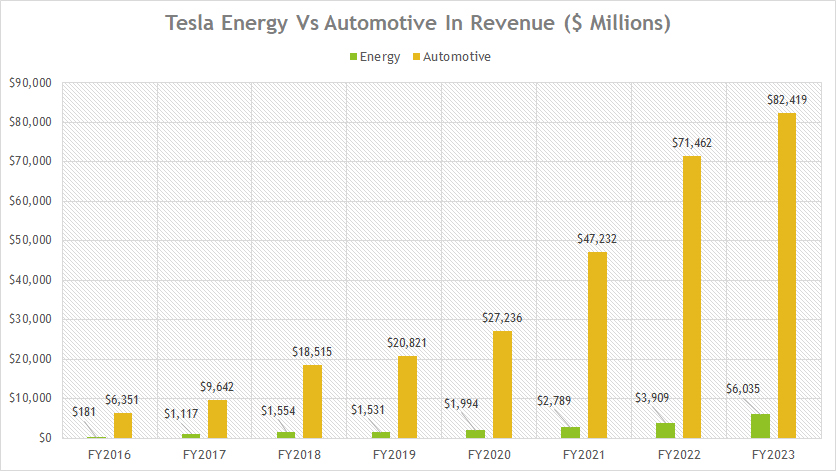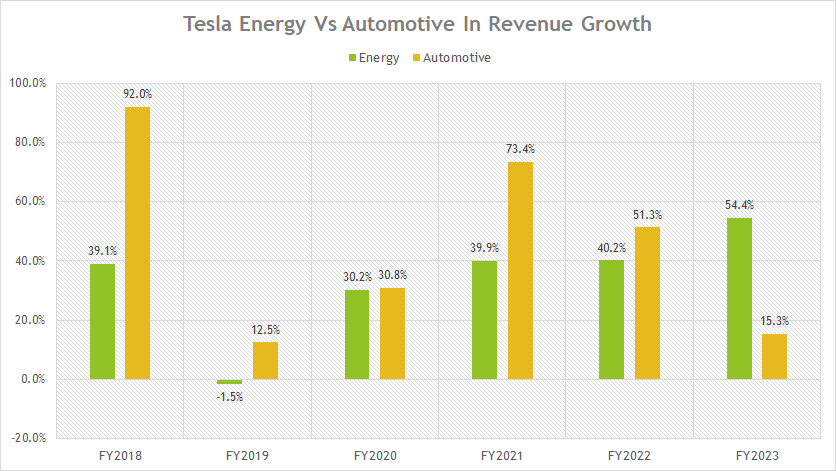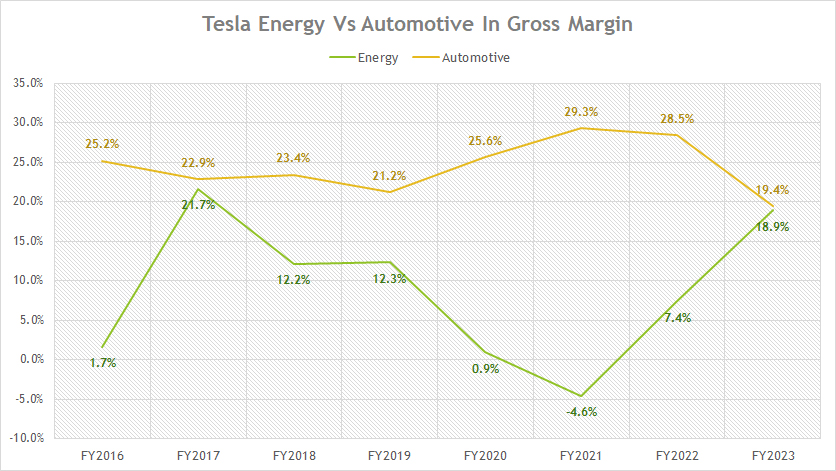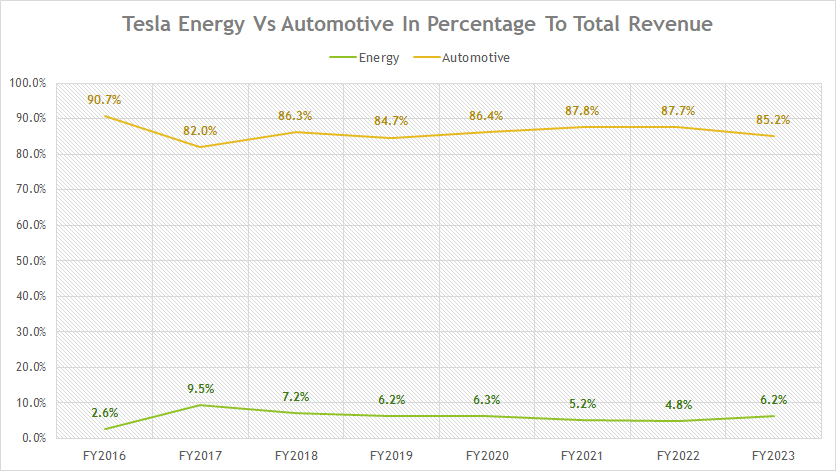
A Tesla battery from an electric car. Flickr Image.
Tesla generates the majority of its revenue from automotive. However, its energy business is booming and is poised for massive profitability.
Elon Musk has suggested that Tesla’s energy segment has the potential to eventually become as large, if not larger, than its automotive business.
The reason is straightforward: Tesla’s entire Supercharger network might eventually be powered by its own energy generation and storage systems.
Additionally, Tesla not only cross-sells its solar products to its automotive customers but also actively promotes a comprehensive renewable energy experience. Tesla encourages its automotive customers to charge their vehicles with solar energy, with its storage and energy generation systems playing a significant role in this vision.
Let’s look at Tesla’s energy and automotive sectors by analyzing their sales revenue, growth rates, and profitability.
You may find related statistic of Tesla on these pages:
Please use the table of contents to navigate this page.
Table Of Contents
Definitions And Overview
O2. Can Tesla Energy Grow To Be As Big As The Automotive?
Revenue
A1. Solar Vs Automotive In Revenue
Growth Rates
A2. Solar Vs Automotive In Revenue Growth
Profitability
A3. Solar Vs Automotive In Gross Margin
As A Percentage Of Total Revenue
A4. Solar Vs Automotive In Percentage To Total Revenue
Summary And Reference
S1. Summary
S2. References and Credits
S3. Disclosure
Definitions Of Ratio
To help readers understand the content better, the following terms and glossaries have been provided.
Energy To Total Revenue Ratio: Tesla’s energy revenue to total revenue ratio measures the proportion of the company’s total revenue that comes from its energy segment, which includes solar products and energy storage systems.
This ratio helps illustrate the significance of Tesla’s energy business relative to its overall revenue. For example, in fiscal year 2023, Tesla’s energy segment accounted for approximately 6.2% of its total revenue. This ratio has been growing, reflecting the increasing importance of Tesla’s energy business.
Automotive To Total Revenue Ratio: Tesla’s automotive revenue to total revenue ratio measures the proportion of the company’s total revenue that comes from its automotive segment, which includes the sales of electric vehicles and automotive regulatory credits.
This ratio helps illustrate the significance of Tesla’s automotive business relative to its overall revenue. For example, in fiscal year 2023, Tesla’s automotive revenue, with regulatory credits revenue included, accounted for approximately 85% of its total revenue. This ratio highlights the dominant role of Tesla’s automotive segment in its overall revenue generation.
Can Tesla Energy Grow To Be As Big As The Automotive?
Tesla’s energy segment has shown impressive growth in recent years, and there’s potential for it to become as large as its automotive business.
In 2023, Tesla’s energy storage deployments increased significantly, and the segment’s revenue grew by over 50%. Elon Musk has predicted that the energy storage business will grow much faster than the car business.
However, the automotive segment still accounts for the majority of Tesla’s revenue. While the energy segment is growing rapidly, it will take time and continued investment to reach the same scale as the automotive business.
Solar Vs Automotive In Revenue
Tesla automotive revenue vs solar revenue (click to enlarge)
According to the chart above, Tesla’s automotive revenue is much bigger than its energy counterpart. For instance, in fiscal year 2023, Tesla’s automotive revenue amounted to $82.4 billion, whereas its energy revenue was only $6.0 billion. Thus, Tesla’s automotive revenue was approximately 14 times higher than its energy revenue.
Additionally, Tesla’s automotive revenue has consistently grown over the past eight years without any decline. In contrast, Tesla’s energy revenue remained relatively stagnant between fiscal years 2017 and 2020.
Solar Vs Automotive In Revenue Growth
Tesla automotive vs solar in growth rates (click to enlarge)
In terms of revenue growth, Tesla’s automotive segment has experienced significantly higher growth rates than the energy sector. For instance, between fiscal years 2021 and 2023, Tesla’s automotive revenue grew by an average of 47% annually, whereas the solar segment grew by 45% annually during the same period.
However, in fiscal year 2023, Tesla’s energy segment achieved a significantly higher growth rate than the automotive segment, with an impressive 54% compared to the automotive’s modest 15%.
Furthermore, the revenue growth of Tesla’s energy segment has been steadily increasing since fiscal year 2021, whereas the automotive segment has experienced a declining growth rate during the same period.
As depicted in the chart above, the revenue growth of Tesla’s solar segment has risen from 40% in fiscal year 2021 to 54% in fiscal year 2023. In contrast, the automotive segment’s revenue growth has declined from 73% to 15% over the same period.
Solar Vs Automotive In Gross Margin
Tesla’s solar vs automotive gross margin (click to enlarge)
In terms of gross margin, Tesla’s automotive segment typically generates a more consistent gross margin compared to the energy segment. However, in fiscal year 2023, the automotive segment’s gross margin dropped significantly to 19.4% from 28.5% the previous year.
Conversely, Tesla’s energy segment saw its gross margin rise sharply to 19% from 7.4% in the previous year, marking a substantial year-on-year increase. With a 19% gross margin, Tesla’s energy segment was as profitable as the automotive segment.
Before 2023, Tesla’s energy segment lagged behind the automotive segment in terms of profitability. One reason for the lower gross margin in Tesla’s energy sector could be the high overhead costs associated with manufacturing and installation processes.
For instance, Tesla’s solar roof is a notable example. As reported by Green Tech Media, Tesla solar roof is both expensive to install and requires highly skilled contractors to ensure professional-grade installation, preventing leaks and ensuring durability for decades.
The high level of professionalism required often translates to a high cost of goods sold for the company. However, things took a positive turn in 2023 when Tesla’s energy gross margin significantly improved, reaching a record 19% by the end of the fiscal year — the best result recorded in the past eight years.
Even though Tesla’s energy gross margin matched that of the automotive segment in fiscal year 2023, it remained significantly lower on average over the past three years. For instance, between fiscal years 2021 and 2023, Tesla’s energy segment had an average gross margin of just 7%, while the automotive sector boasted an average gross margin of 26%.
In summary, Tesla’s automotive segment remains significantly more profitable than its energy segment.
Solar Vs Automotive In Percentage To Total Revenue
Tesla’s solar and automotive revenue to total revenue ratio (click to enlarge)
Tesla’s automotive segment still accounts for the majority of the total revenue, as shown in the graph above.
In fiscal year 2023, Tesla’s automotive segment accounted for 85% of its revenue, compared to just 6% from the solar segment. These proportions have remained relatively stable over the past few years, underscoring the dominant role of the automotive business in Tesla’s overall revenue.
Conclusion
In summary, while Tesla’s automotive segment remains dominant in terms of revenue and profitability, the energy segment has shown impressive growth and improvements in gross margin, suggesting a potential for future expansion.
References and Credits
1. All financial figures presented in this article were obtained and referenced from Tesla’s annual reports published in the company’s investor relation page: Tesla Press Releases.
2. Flickr Images.
Disclosure
We may utilize the assistance of artificial intelligence (AI) tools to produce some of the text in this article. However, the data is directly obtained from original sources and meticulously cross-checked by our editors multiple times to ensure its accuracy and reliability.
If you find the information in this article helpful, please consider sharing it on social media. Additionally, providing a link back to this article from any website can help us create more content like this in the future.
Thank you for your support and engagement! Your involvement helps us continue to provide high-quality, reliable content.





Tesla energy and solar is different. Solar is going down each year since solar city.